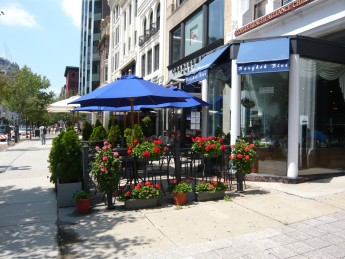|
It’s everybody’s neighborhood, actually. Boston is one of the greatest iconic American cities, source of so much history and character in a growing nation.
Not being a Yankee fan, I never bought into the obscenities, the hard feelings, the rivalry. There’s no place like Fenway or the old Boston Garden, for that matter, or the Marathon. People who ran it talk with awe about striding down Boylston. Years ago, I drove my young son up on Patriots' Day; we left at 4 AM and actually bought tickets and sat behind right field and watched Fred Lynn's game-ending home run get larger and larger as it flew into the next section. Then we walked down to Boylston and watched the early wave of finishers. That day will make a Boston fan out of anybody. Boston is the place to send children for college; it’s the great young-person’s city in America. (Our three all got a visit to Boston to visit colleges, but somehow resisted.) Boston sends strong people out in the world. In New York, we hear the accents of Michael Bloomberg and Suzyn Waldman. Never lose them, kids. And Boston keeps strong people. Two people I care about could easily have been near the finish line on Monday; in past years they would have been. I needed message assurance that they were all right, and they were. Now we have so many more people to care about. One other thing: In recent years, my wife and I have made glorious trips to Boston, usually staying a block or two from Boylston and wandering down to the T station to catch a movie in Cambridge or visit one of the art museums. Often we stop in at the Bangkok Blue Thai restaurant at 755 Boylston, consistently good, feels like home. The last time we were in there, a couple of workers were planning to take one of those bargain buses to Manhattan for a day of sight-seeing. We gave tips on the best way to see our city. To me, Boston and New York are linked far beyond cheapo bus lines or the shuttle or Amtrak, or some baseball rivalry. Boston is the great city where we have never quite lived. I’ve tried calling and e-mailing Bangkok Blue in hopes that everybody is all right. No answer, so far.
Becky Collet
4/17/2013 02:17:14 am
A wonderful tribute to my city from a dear friend.....Boston loves you too George....
Brian Savin
4/17/2013 03:19:09 am
Never been scared like this before. Our daughter lives in Boston. She had lots of friends visiting her who were running the Marathon. We were in a sausage shop in Hartford when someone came in with the news. He said it happened at the finish line. Call Meg! My wife quickly pulled out her cell phone. It took ten long minutes before she received that wonderful text message sound: "Everyone OK, will call soon." We were at the Atlanta Olympics when that bomb exploded. Funny, but when I was there then, I didn't feel as scared. I felt more in control. It is so very preferable to be in the midst of danger than to be removed from it while loved ones are not. I'm lucky today, but hundreds of families not as much. That makes me sad, and very, very angry.
George Vecsey
4/17/2013 04:10:31 am
Brian and Everybody: Read Tom Friedman's column in the NYT today.
Karen Koshner
4/17/2013 07:04:51 am
We welcome you back. And soon. 4/18/2013 09:28:02 am
George
George Vecsey
4/18/2013 12:49:36 pm
Alan: I agree with you. The Gaby Giffords Op-Ed piece in the NYT is excellent. GV 8/6/2013 01:44:42 am
Really your post is really very good and I appreciate it. It’s hard to sort the good from the bad sometimes, but I think you’ve nailed it. You write very well which is amazing. I really impressed by your post 1/7/2015 10:15:25 pm
wonderful articles and the quality of your articles are too good.. I am loving it .. Comments are closed.
|
Categories
All
|










